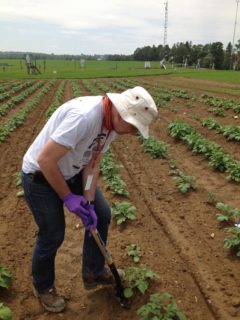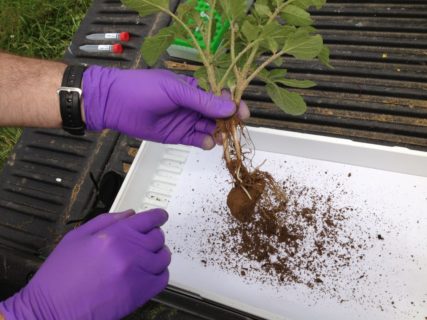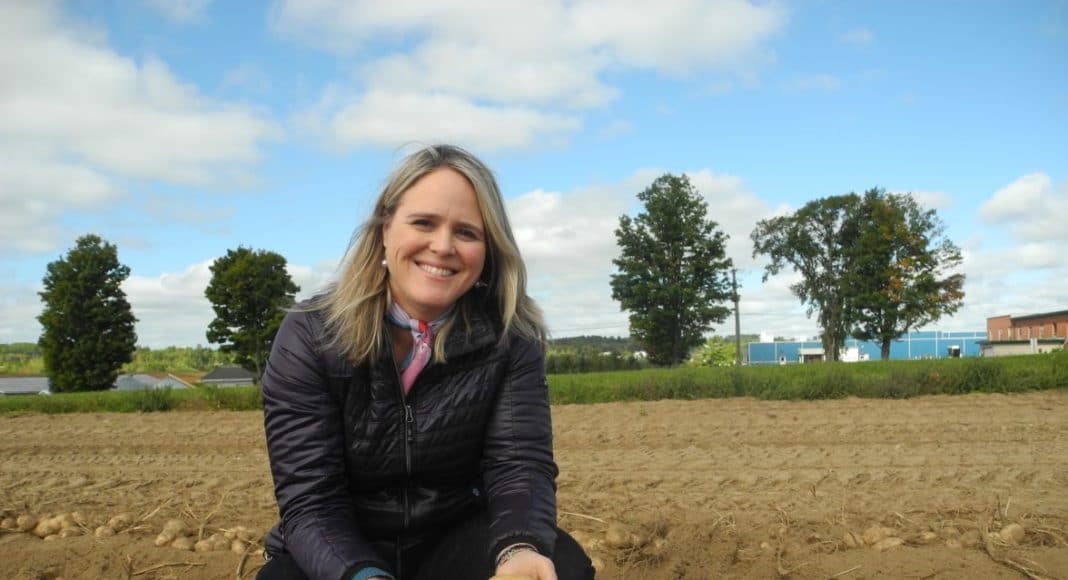[deck]The effect of common scab on tubers partly depends on the potato cultivar. But how does the cultivar affect the pathogen?[/deck]
According to Claudia Goyer, a molecular bacteriologist with Agriculture and Agri-Food Canada (AAFC) in Fredericton, N.B, cultivars differ in terms of how severe common scab will be. No cultivars have true resistance to common scab, where there is no disease at all.
“All of them can get common scab. The tolerant ones get really minimal amounts of the disease, just a couple of lesions here and there. The susceptible ones get a lot,” she says.
“In our project, we wanted to better understand how the cultivar is affecting the abundance of common scab pathogens and how the abundance changes over time. We were intrigued to see if some cultivars would sustain or feed the growth of more of the pathogens. We suspected susceptible cultivars might harbour more pathogens than the tolerant cultivars, but we wanted to see if there was evidence of that.”
Common scab is caused by some of the soil bacterial species in the genus Streptomyces. In the Maritimes, the most common pathogenic species is Streptomyces scabies.
Although several methods are available to help manage common scab, none of them are totally effective. By increasing our understanding of the mechanisms influencing the abundance of common scab pathogens, Goyer hopes to make improved recommendations for managing this widespread disease.
Cultivar Project
Goyer led the cultivar project, working with her AAFC Fredericton colleagues Bernie Zebarth, Kamrun Nahar, Sean Whitney and Catherine Clark, and with David Burton at Dalhousie University. They recently published a scientific paper on the results. AAFC’s AgriInnovation Program funded the research.
The researchers compared two tolerant cultivars, Gold Rush and Hindenburg, and two susceptible cultivars, Green Mountain and Agria.

Photo: Claudia Goyer/AAFC
“I delved into the literature to make sure that I was choosing cultivars that were truly tolerant. Whether a cultivar is tolerant or not to common scab depends on where you are — the soil’s physicochemical properties, the aggressiveness of the pathogen strains, and the environmental conditions. For instance, in Canada we might say Russet Burbank is really tolerant to common scab, but in Australia they consider Russet Burbank as susceptible,” says Goyer.
“For my tolerant cultivars, I picked ones that were acknowledged as very tolerant to common scab in multiple research papers and at multiple locations. It was very easy to pick susceptible cultivars because there’s a lot of them; there are more susceptible cultivars than tolerant ones.”
She also chose cultivars that matured at about the same rate, so they would be more comparable with each other.
In 2013 and 2014, Goyer and her project team planted the cultivars in replicated plots in a common scab-infested field at AAFC Fredericton. The field is like a common scab nursery for Goyer’s research; she nurtures the infestation to keep inoculum levels high.
The team collected soil samples and measured soil temperature and moisture at several times each year:in the spring at planting, four times during the growing season and after harvest.
At each sampling time, they collected soil from three types of locations: the bulk soil close to the plant; the rhizosphere, which is the narrow soil zone influenced by the plant’s roots; and the geocaulosphere, which is the tuber’s surface.
“The bulk soil is soil where typically you have a whole lot of microbial diversity, with lots of bacteria and fungi. The bulk soil shows the pathogens’ abundance when no plant is influencing the conditions,” Goyer says.
“The plant influences the soil up to about one to five millimetres away from the roots. The roots leak amino acids, sugar and phenolic acids into this zone, and those exudates feed and sustain the growth of a lot of organisms. The rhizosphere is usually a hot spot for microbial activity, but it actually has fewer species than the bulk soil. That is because the plant’s exudates favour certain species. You have fewer microbial species, but the ones that are present are more abundant and more active.”

Photo: Claudia Goyer/AAFC
The geocaulosphere is the crucial location for common scab infections.
“Based on my experience, the common scab pathogens grow very happily in the rhizosphere without causing any disease issues. Unless the pathogen is very aggressive and the conditions are really conducive to the disease, you rarely see any symptoms on the roots. The geocaulosphere is where the trouble starts with the common scab pathogens. The pathogen colonizes the tuber surface and enters through the lenticels. Then it starts to cause lesions, and as the tuber enlarges, the lesions enlarge,” she says.
“The geocaulosphere is an intriguing environment. Not much is known about it, including exactly what sustains the microbial communities on the geocaulosphere.”
Goyer’s teamextracted the DNA from the soil samples and used quantitative PCR to measure the abundance and next-generation sequencing to evaluate the diversity of the soil bacterial communities. To identify and quantify any pathogenic Streptomyces species, they analyzed the samples for a gene that is important for common scab pathogenicity. The team also measured soil texture, pH and organic carbon in the soil samples.
Susceptible Cultivars Leave a Disease Legacy
This project found clear differences between the effects of susceptible and tolerant potato cultivars on common scab populations. “There were greater abundances of the Streptomyces pathogens with the susceptible cultivars compared to the tolerant cultivars when we averaged the data over all of the sampling times and all of the locations,” says Goyer.
“We had five to six times more abundant common scab pathogens in the rhizosphere of the susceptible cultivars compared to the tolerant ones.” This impact of susceptible cultivars on common scab populations has never been proven before.
The researchers also investigated whether the cultivars had a direct effect on the pathogens’ population or an indirect effect through causing other changes in the soil microbial community. For example, perhaps the tolerant cultivars promoted the growth of certain microbes that then suppressed the common scab pathogen. However, they found that the cultivar effects on microbial diversity were subtle, suggesting that the microbial communities did not have a clear, direct role in changing the pathogens’ abundance.
The results suggest that the cultivar’s effects on the soil properties were the crucial factor in the pathogens’ abundance.
“We found that the soil properties explained 76 per cent of the variation in Streptomyces abundance. That suggests the cultivars influence the growing conditions of the pathogenic Streptomyces, and that the composition of the root exudates of the susceptible cultivars are more favourable for growth of the pathogen,” says Goyer.
The results also showed that the pathogens’ abundance rose during the growing season. “In the rhizosphere and geocaulosphere, there was a clear increase in the pathogens’ abundance in August, especially in the susceptible cultivars. We think the plant starts to senesce, to die off, in August, and Streptomyces likes that.”
“All Streptomyces species are excellent decomposers and are very useful in decomposing plant residue and turning that into organic matter. Streptomyces pathogens are able to live and increase in the soil if there is plant residue as a source of carbon; they can live happily without infecting a plant. We think that in August, the plant’s dying roots are feeding the pathogen,” says Goyer.
In the future, she would like to continue soil sampling later into the fall and as soon as sampling can start in the spring to find out if and how the pathogens’ population changes.
Overall, the key message for growers is if they choose a susceptible cultivar, they will have greater disease severity in their potato crops, plus the crops will leave substantially higher pathogen levels in their fields by harvest time, and the susceptible cultivar’s roots remaining in the field after harvest could possibly continue to feed those high pathogen populations.
Next Steps
At present, Goyer and her team are working on another paper related to this research. The paper will examine the interactions between the different microbial species in the rhizosphere and geocaulosphere.
Next summer, Goyer will be starting a new study to look at the effects of crop rotation on common scab. “In the past, we have looked at the effects of agricultural practices on common scab, but we would like to quantify the effects on the common scab pathogens’ abundance, the soil physicochemical properties and the environmental conditions in order to really understand the mechanisms behind the changes in abundance,” she explains.
“For instance, does a particular crop cause the soil carbon to increase and that increases the number of microbial species, and that reduces the pathogens? If we grow a mustard crop, does the isothiocyanate — a compound produced by the mustard residue when it is ploughed into the soil — decrease the pathogen’s abundance, and does the abundance stay low after that? Would a nurse crop in the spring reduce the pathogens?
“We want to answer those types of questions and to understand why certain practices work at certain sites but not at others. Once we better understand the mechanisms and the influences on the pathogens’ abundance, then we hope to come up with robust recommendations for decreasing the severity of common scab.”











